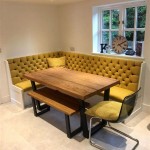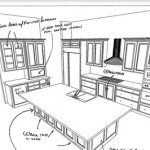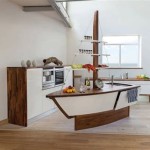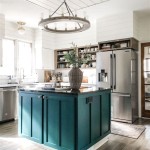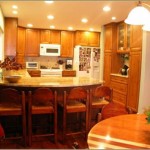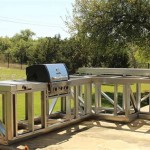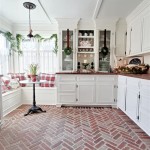Kitchen Island Counter Ideas: Functionality Meets Style
The kitchen island has evolved from a simple workspace to a central hub in modern homes. Serving as a food preparation area, dining space, storage solution, and social gathering spot, the kitchen island demands a countertop that is both aesthetically pleasing and highly functional. Selecting the right countertop material, size, and design is crucial for maximizing the island's utility and enhancing the overall kitchen aesthetic. This article explores a variety of kitchen island counter ideas, focusing on factors to consider when choosing the most suitable option for specific needs and preferences.
The ideal kitchen island countertop should withstand the rigors of daily use, resist stains and scratches, and complement the kitchen's existing design elements. The material significantly impacts the countertop's durability, maintenance requirements, and overall cost. Size and shape directly affect the available workspace and the island's function. Design choices, such as edge profiles and color, contribute to the kitchen's visual appeal.
Material Selection: Balancing Durability and Aesthetics
The choice of countertop material is paramount. Each material offers a unique combination of durability, aesthetics, and price. Popular options include granite, quartz, marble, butcher block, stainless steel, concrete, and laminate. Understanding the properties of each material is essential for making an informed decision.
Granite: Granite is a natural stone prized for its durability and unique patterns. It is heat-resistant, scratch-resistant, and relatively stain-resistant when properly sealed. Granite countertops can withstand heavy use and maintain their beauty for years. However, granite is porous and requires periodic sealing to prevent staining. The price of granite varies depending on the color and veining, with some varieties being significantly more expensive than others.
Quartz: Quartz is an engineered stone made from crushed quartz crystals and resin. It offers a consistent appearance and superior durability compared to granite. Quartz is non-porous, making it highly resistant to stains and bacteria. It does not require sealing and is easy to maintain. Quartz is available in a wide range of colors and patterns, including options that mimic the look of natural stone. While generally more expensive than granite, the low maintenance requirements of quartz can offset the initial cost over time.
Marble: Marble is a luxurious natural stone known for its elegance and distinctive veining. It adds a touch of sophistication to any kitchen. However, marble is a softer stone than granite or quartz and is more susceptible to scratches and stains. It requires regular sealing and careful maintenance to preserve its beauty. Marble is better suited for low-traffic areas or as an accent material rather than the primary countertop surface for high-use kitchen islands.
Butcher Block: Butcher block countertops are made from strips of hardwood glued together. They offer a warm, natural aesthetic and are ideal for food preparation. Butcher block is durable and can withstand years of use with proper care. It requires regular oiling to prevent drying and cracking. While butcher block can be used for cutting and chopping, it is important to use separate cutting boards to avoid excessive wear and tear. It is also susceptible to water damage and must be kept dry to prevent warping.
Stainless Steel: Stainless steel countertops are a popular choice for professional kitchens due to their durability, hygiene, and heat resistance. They are non-porous and easy to clean, making them ideal for food preparation. Stainless steel countertops are resistant to stains and bacteria. However, they can be prone to scratches and dents and may show fingerprints. The aesthetic of stainless steel is modern and industrial, which may not suit all kitchen styles.
Concrete: Concrete countertops offer a unique, contemporary look. They are custom-made and can be shaped and colored to suit any design. Concrete is durable but porous and requires sealing to prevent staining. It is also prone to cracking, and regular maintenance is necessary to keep it looking its best. Concrete countertops can be heavy and require strong support. The cost of concrete countertops can vary depending on the complexity of the design and the chosen finish.
Laminate: Laminate countertops are a cost-effective option that offers a wide range of colors and patterns. They are made from layers of plastic bonded to a particleboard core. Laminate is easy to clean and maintain, but it is not as durable as other countertop materials. It is susceptible to scratches, stains, and heat damage. Laminate is a suitable option for budget-conscious homeowners who prioritize affordability over durability.
Size and Shape: Optimizing Functionality and Flow
The size and shape of the kitchen island countertop should be proportionate to the size of the kitchen and the island itself. The countertop should provide ample workspace without obstructing traffic flow. Consider the intended use of the island when determining its size and shape. A larger island is needed for food preparation, dining, and storage, while a smaller island may suffice for basic tasks and social gatherings.
Size Considerations: The ideal size of the kitchen island countertop depends on the available space and the desired functionality. A minimum of 36 inches of clearance should be maintained between the island and surrounding cabinets or walls to allow for comfortable movement. The countertop should be large enough to accommodate the intended tasks, such as food preparation, dining, or homework. A standard island countertop height is 36 inches, which is the same as standard kitchen countertops. For counter-height seating, a height of 42 inches is recommended.
Shape Considerations: The shape of the kitchen island countertop can significantly impact the kitchen's layout and flow. Rectangular islands are the most common, but other shapes, such as L-shaped, U-shaped, and circular islands, can also be effective. L-shaped islands are ideal for corner spaces, while U-shaped islands provide ample workspace and storage. Circular islands create a more intimate and social atmosphere. The shape of the island should complement the kitchen's overall design and optimize the available space.
Extending Countertops: Another popular design idea is extending the countertop beyond the island base to create an overhang for seating. This overhang should be at least 12 inches deep to provide adequate legroom. The extended countertop can be made from the same material as the rest of the island or from a contrasting material for a more dynamic look.
Design Elements: Enhancing Visual Appeal and Function
Beyond material and dimensions, design elements play a crucial role in the island countertop's contribution to the kitchen's style. Edge profiles, color, and the inclusion of additional features can significantly enhance both the visual appeal and the functionality of the island.
Edge Profiles: The edge profile of the countertop refers to the shape of the countertop's edge. Different edge profiles can create different visual effects. Common edge profiles include bullnose, ogee, eased, and waterfall edges. Bullnose edges are rounded and soft, while ogee edges are more decorative and elaborate. Eased edges are simple and clean, while waterfall edges create a seamless transition from the countertop to the floor. The choice of edge profile should complement the kitchen's overall design and the chosen countertop material.
Color and Pattern: The color and pattern of the countertop should coordinate with the kitchen's existing color scheme and design elements. Light-colored countertops can brighten up a dark kitchen, while dark-colored countertops can add drama and sophistication. Consider the undertones of the cabinets and flooring when choosing a countertop color. Natural stone countertops offer unique patterns and variations, while engineered stone countertops offer a more consistent appearance. The choice of color and pattern should reflect personal preferences and complement the kitchen's overall style.
Additional Features: The inclusion of additional features can enhance the functionality of the kitchen island countertop. Built-in sinks, cooktops, and cutting boards can streamline food preparation. Outlets and USB ports can provide convenient power access for appliances and electronic devices. Storage solutions, such as drawers, cabinets, and shelves, can maximize the island's storage capacity. Wine racks and beverage refrigerators can transform the island into a stylish entertainment center. The choice of additional features should be based on individual needs and preferences.
When selecting a kitchen island countertop, it's important to consider the overall design of the kitchen, the intended use of the island, and personal preferences. By carefully considering the material, size, shape, and design elements, homeowners can choose a countertop that is both functional and aesthetically pleasing.

90 Modern Kitchen Island Ideas To Transform Your Home In 2025

25 Simple And Stylish Kitchen Island Decor Ideas

22 Small Kitchen Island Ideas For Ultimate Functionality And Style Lx Hausys

When It Comes To Countertop Design Raised Bars Are A Thing Of The Past

6 Top Looks For Your Kitchen Island Or Countertop Niro Granite

Kitchen Island Ideas Pictures Houselogic

Kitchen Island Designs With Stainless Steel Countertop

Crafting The Ideal Kitchen Island Layouts Tips And Examples

47 Best Kitchen Island Ideas Stylish Unique Design Tips

10 Modern Kitchen Island Ideas Atlas Plan
Related Posts

